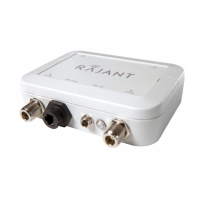Note
Note
Note, the frequency noted is the center frequency of the base 20 MHz channel. HT40 operation (+ or -) is
Note, the frequency noted is the center frequency of the base 20 MHz channel. HT40 operation (+ or -) is
compatible with 802.11b and 802.11g 20 MHz, and 802.11n HT20 modes.
compatible with 802.11b and 802.11g 20 MHz, and 802.11n HT20 modes.
A.2 Radio: 5 GHz 802.11ac
Table: 5 GHz 802.11ac Radio Channels and Frequencies
Channel Number Center Frequency (MHz) HT40 Capability VHT80 Capability
36 5180 HT40 + VHT80
40 5200 HT40 - VHT80
44 5220 HT40 + VHT80
48 5240 HT40 - VHT80
52 5260 HT40 +
56 5280 HT40 -
60 5300 HT40 +
64 5320 HT40 -
100 5500 HT40 +
104 5520 HT40 -
108 5540 HT40 +
112 5560 HT40 -
116 5580 HT40 +
120 5600 HT40 -
124 5620 HT40 +
128 5640 HT40 -
132 5660 HT40 +
136 5680 HT40 -
140 5700 HT20 only
144 VHT80 only
149 5745 HT40 + VHT80
153 5765 HT40 - VHT80
157 5785 HT40 + VHT80
161 5805 HT40 - VHT80
165 5825 HT20 only
In the United States, for a BreadCrumb 5 GHz 802.11ac radio, the default channel number is 157 (5785
MHz) with channel mode HT40+. For a second 5 GHz 802.11ac radio (if present), the default channel num-
ber is 48 (5240 MHz) with channel mode HT40-.
In Canada, for a BreadCrumb 5 GHz 802.11ac radio, the default channel number is 157 (5785 MHz) with
channel mode HT20+. For a second 5 GHz 802.11ac radio (if present), the default channel number is 48

